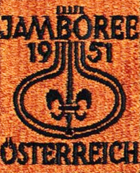7th World Scout Jamboree
| 7th World Scout Jamboree | |||
|---|---|---|---|
 | |||
| Theme | Jamboree of Simplicity | ||
| Location | Bad Ischl | ||
| Country | Austria | ||
| Date | August 3 to 12, 1951 | ||
| Attendance | 12,884 Scouts | ||
|
| |||
The 7th World Scout Jamboree was held August 3 to 12, 1951 and was hosted by Austria at Bad Ischl. The attendance was 12,884 from 61 different parts of the world, with 675 German Scouts given a warm welcome as official participants in a World Jamboree for the first time. The Austrian contingent was slightly outnumbered by the Commonwealth contingent, and had reduced the minimum age for their attendees from 14, the normal Jamboree age, to 13, since the revived organization had only been in existence for five years.
Prologue
At the 1949 International Scout Conference in Norway, invitations for the 1951 Conference and quadrennial World Jamboree were presented by Austria and Denmark. The vote was overwhelmingly in favor of Austria as it was a small country, a World Jamboree had never been staged there, Austrian Scouts had been forbidden in 1938 and had made their own comeback in 1946. The majority of the countries represented at the Conference had been at war with the then Austrian State only five years before, and there was an intence desire to show the brotherhood of Scouting was a reality.
In voicing the invitation, the Austrian International Commissioner, Adolf Klarer, said thar the Seventh Jamboree "would have to put up with great simplicity." This itself appealed to the Conference as suiting the primary purpose of World Jamborees, to bring Scouts together from all over the world and so strengthen the feeling of unity and fellowship, so the "Jamboree of Simplicity" was born.
Jamboree
As at the 1947 Moisson Jamboree, there were many difficulties to be overcome by the 10,000 Austrian Scouts. The Austrian government administered the country under foreign control, still divided into American, British, Soviet and French occupation zones. Preparations were started immediately, and the site near Bad Ischl in the Salzkammergut was selected in November 1949 while snow lay on the ground.
The budget for the Jamboree was fixed at six million Austrian Schillings, after J. S. Wilson added 15% to the Austrian estimate, anticipating that staples like milk would inflate in price, which they did. 500,000 Schillings were granted as a subsidy of the Austrian Federal Government.
Doubts has been expressed because while Bad Ischl was in the American Zone, it lay close to the Soviet Zone. However, Austrian Scout troops had been permitted to start and carry on quietly in the Soviet Zone, and no attempt was made to interfere with them, so members of these troops also attended the Jamboree.
During the event seven lit towers were erected to symbolize previous Jamborees. As the name of each Jamboree was announced, a flag was hoisted on one of the towers and the song of that Jamboree sung.
One Scout attended from Japan, knowing no language other than his own and the word "Jamboree", yet he made the journey with no problem. The sight of Scouts waving the welcome flags at the airport told him that he had arrived at the right place.
Contingents came from Algeria, Armenia, Australia, Belgium, Bolivia, Brazil, British Guyana, Burma, Cameroon, Canada, Ceylon, Chile, Cuba, Cyprus, Denmark, Germany, Egypt, El Salvador, France, French Equatorial Africa, French West Africa, Gibraltar, Great Britain, Greece, Hong Kong, Iceland, India, Iraq, Ireland, Italy, Jamaica, Japan, Kenya, Lebanon, Liechtenstein, Luxembourg, Madagascar, Malaya, Mexico, Morocco, Malta, the Netherlands, New Zealand, Nigeria, Norway, Pakistan, Portugal, Sierra Leone, Southern Rhodesia, South Africa, Sudan, Sweden, Switzerland, Syria, Togo, Tunisia, the United States, Venezuela and Vietnam. Exile Scouts from Eastern Europe participated in the contingents of Germany and Austria.
Reunions
The Australian contingent to the 7th World Jamboree still has reunions every two years. In 2009 about 45 people are expected to be present. It is believed that the Australian contingent is the only contingent in which the members are still in contact with each other.[citation needed]
See also
References
- Scouting Round the World, John S. Wilson, first edition, Blandford Press 1959 p. 214-217
- http://www.scout.org/wsrc/fs/jamboree_e.shtml